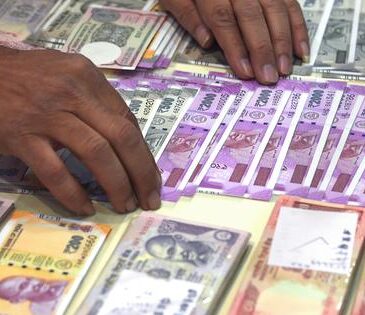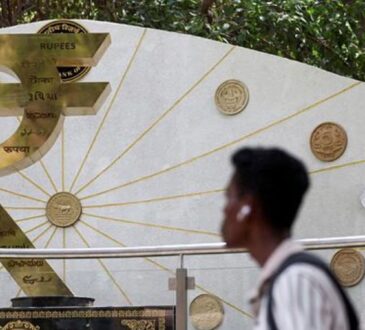Asia-Pacific markets slide after Trump’s tariff announcement rocks sentiment – NBC New York
This is CNBC’s live blog covering Asia-Pacific markets.
Asia-Pacific markets plunged on Thursday, after U.S. President Donald Trump imposed hefty reciprocal tariffs on over 180 countries and territories — several of which are in the region.
In charts posted on social media, the White House showed the effective tariff rates they claim other countries impose on American goods, including by “currency manipulation and trade barriers.”
The White House told CNBC’s Eamon Javers on Wednesday that the new reciprocal rate on China will be added to existing tariffs totaling 20%, meaning the true tariff rate on Beijing under this Trump term is 54%.
Meanwhile, goods from India, South Korea and Australia face tariffs of 26%, 25% and 10%, respectively.
Chris Kushlis, chief emerging markets Macro Strategist at T. Rowe Price says the fresh tariffs “represent a significant increase in tariffs on Asian exports, and arguably more than anticipated by the market.”
The U.S. accounts for approximately 15% of exports from the region, meaning that tariff increases ranging between 20% and 35% “would pose a meaningful headwind to growth this year, especially for the more open trade-oriented economies,” he noted.
“Many Asia economies have a relatively high proportion of their export value added that ends up in the U.S., so the broad application of tariffs globally will hinder effects to redirect trade,” Kushlis added.
What is interesting is that China “which has the biggest trade deficit with the U.S. does not have the largest reciprocal tariffs,” said Stephen Dover, chief market strategist and head of Franklin Templeton Institute at Franklin Templeton.
Instead, he highlighted that Southeast Asia — which has benefitted from past tariffs on China — has “some of the highest reciprocal tariffs.”
Japanese markets led losses in Asia. The benchmark Nikkei 225 pared losses of over 4% to end the day 2.77% lower at 34,735.93, while the broader Topix index closed down 3.08% at 2,568.61.
Over in South Korea, the Kospi index pared losses from over 3% to close 0.76% lower at 2,486.70, while the small-cap Kosdaq fell 0.2% to 683.49.
Mainland China’s CSI 300 fell 0.59% to end the day at 3,861.50, while Hong Kong’s Hang Seng Index declined 1.52% to 22,849.81.
India’s benchmark Nifty 50 dropped 0.26% while the broader BSE Sensex declined 0.36% as at 1.45 p.m. local time.
Australia’s S&P/ASX 200 fell 0.94% to close at 7,859.70. The country’s S&P Global Purchasing Managers’ Index reading came in at 51.6 in March, compared to 51.3 in the month before.
Spot gold hit a record high and was trading at $3,130.19 per ounce as at 4.20 p.m. Singapore time, as investors flocked to the precious metal.
Looking ahead, Franklin Templeton’s Dover said that the tariffs “do not work if prices do not increase.”
“The average American family may pay up to an estimated $4,200 more per year because of today’s tariffs (assuming an average 20% tariff rate on imports),” he wrote in a Thursday note.
What this means is that the tariffs, will likely slow household and business spending, thereby increasing the “risk of U.S. growth and earnings disappointments in 2025,” Dover added.
U.S. futures cratered over concerns of a global trade war that would adversely affect the already slowing U.S. economy.
Overnight stateside, stocks climbed in yet another volatile session.
The S&P 500 advanced 0.67% to close at 5,670.97, while the Nasdaq Composite added 0.87% and ended at 17,601.05.
The 30-stock Dow Jones Industrial Average added 235.36 points, or 0.56%, and settled at 42,225.32.
Shares of Tesla climbed 5.3%, rising on news that President Trump has signaled to his cabinet that Elon Musk will be stepping back
— CNBC’s Brian Evans and Sean Conlon contributed to this report.
Trump’s tariffs on Chinese exports may shave off China’s GDP growth by 2%-2.5%: Macquarie Capital
China faces a net tariff of 54% on its exports to the U.S. starting April 9.
This could shave 15 percentage points off China’s exports and between 2 and 2.5 percentage points of its GDP growth, analysts at Macquarie Capital estimated.
The impact of the tariffs “could manifest itself through multiple channels such as falling U.S demand for Chinese goods, the potential global economic slowdown and the hit on export re-routing,” the asset manager’s economists Larry Hu and Yuxiao Zhang wrote in a Thursday note.
They expect Beijing to respond by implementing a policy put against tariff, taking a U-turn on its regulatory campaign, and retaliating with tariff and non-tariff measures.
Other strategies Hu and Zhang expect from China include pushing inflationary pressures on the U.S. and diversifying exports to other markets such as the European Union, East Asia, Southeast Asia and Latin America.
Looking ahead, the economists believe that the impact of the tariffs will still be “manageable for Beijing.”
“We expect Beijing to stimulate domestic demand to offset the impact of tariffs, so that they could still achieve the growth target of around 5%,” they added.
Hu and Zhang are drawing reference to 2021 to forecast how markets may respond. Back then, Beijing cracked down on property and big tech following a 30% acceleration in Chinese exports.
This year, “policymakers may respond by doing just the opposite of 2021,” they said, as exports slow substantially.
— Amala Balakrishner
Hang Seng Index drops over 2%
Hong Kong’s Hang Seng Index plunged 2.16% on Thursday as at 1.28 p.m. local time.
The losses were led by the industrials, healthcare and basic materials sectors.
The worst performing stocks on the index were Shenzhou International Group Holdings, which plunged 13.66%, Techtronic Industries which dropped 12.47% and BYD Electronic International which lost 9.72%.
Many major Chinese companies are listed on the index, which is up 13.58% since the start of the year.
Meanwhile, the Hang Seng Tech Index was down 3.10%, extending losses from earlier in the session.
— Amala Balakrishner
Trump’s 26% tariffs on Indian exports ‘much worse than expected’: Macquarie Capital
U.S. President Donald Trump’s 26% tariffs on all imports from India is “much worse than expected,” experts at Macquarie Capital say.
“Our primary reading is that in case the 26% tariffs suggested by the White House is a blanket tariff applied across all India products, it could be pretty negative,” the asset management house’s analysts led by Suresh Ganapathy, wrote in a Thursday note.
India ran a trade surplus of $45.7 billion with the U.S. as of 2024.
Macquarie notes that 14%, or $12.7 billion, the South Asian giant’s exports to the U.S. are pharmaceuticals, which are currently exempted from tariffs.
Against this backdrop, the asset manager’s experts forecast “downside risk” to the Reserve Bank of India’s GDP projection of 5.6% for FY2025 and FY2026 due to the trade wars.
Indian markets opened lower with the benchmark Nifty 50 down 0.14% while the broader Sensex lost 0.33% as at 10.26 a.m. local time.
The Indian rupee fell 0.25% against the U.S. dollar to 85.66.
— Amala Balakrishner
China’s services activity grows at three-month high, Caixin PMI shows
China’s services activity expanded at the fastest pace in three months in March, driven by stronger business activity and new orders, a private survey showed on Thursday.
The Caixin/S&P Global services purchasing managers’ index (PMI) rose to 51.9 in March from 51.4 in February, staying above the 50-mark that separates expansion from contraction.
This was consistent with the official PMI, which showed services picked up to 50.3 in March from 50.0 in February.
The new orders rose to the quickest in three months, boosted by “firmer domestic demand,” Caixin said, while the volume of new export business was unchanged.
Employment in the services sector, however, fell into the negative territory, as businesses remained cautious with hiring.
— Anniek Bao
Oil prices fall after Trump announces tariffs
Oil prices fell after the rollout of President Donald Trump’s tariffs fueled worries of the state of the U.S. economy. Global benchmark Brent slipped 2.82% to $72.86 a barrel, while U.S. West Texas Intermediate futures dipped 2.89% to $69.67 per barrel.
A senior official reportedly told Reuters that goods from Mexico and Canada that comply with the USMCA, including oil, should be exempt from the tariffs.
Lee Ying Shan, Reuters
HSI Tech drops over over 2%
Hong Kong’s Hang Seng Tech Index traded 2.3% lower as at 11.35 a.m. local time on Thursday.
Among the worst performers in the index were Lenovo Group which plunged 8.07%, BYD Electronic International, which dropped 7.87%, and Haier Smart Home which lost 7.63%.
The Hang Seng Tech Index ETF shows the day’s moves:
— Amala Balakrishner
Japanese and South Korean auto stocks fall
Japanese and South Korean auto stocks plunged on Thursday on the back of U.S. President Donald Trump’s 25% tariffs on all auto exports to the U.S.
That amount will cover over $460 billion worth of annual exports of vehicles and auto parts to the U.S., according to a Reuters analysis of tariff codes included in a federal register notice.
Mazda Motor led losses in Japanese automakers, plunging 6.33% as at 12.08 p.m. local time.
Other stocks that logged steep losses include Isuzu Motors which fell 5.73% and Toyota Motor, which had dropped 5.2%.
Over in South Korea, Kia Corp slid 1.09% while Hyundai Motor was down 1.22%.
— Amala Balakrishner
Australian mining stocks fall on Trump’s tariff announcement
Australian mining stocks saw substantial declines on Thursday, on the back of U.S. President Donald Trump’s fresh tariff announcement.
Sharp declines were seen in major miners, with Rio Tinto falling 2.81%, BHP Group dropping 2.07% and Fortescue sliding 2.04% as at 1.30 p.m. Australian Eastern Daylight Time.
Gold miners, meanwhile, traded mixed even as gold prices notched a record high.
Newmont Corporation and Northern Star Resources were up 1.91% and 1.99% respectively. Conversely, losses were seen in Evolution Mining, which was down 1.13% and Kingsgate Consolidated, which lost 0.34%.
— Amala Balakrishner
U.S. tariff rates could hit ‘levels not seen since the early 20th century’: J.P. Morgan Asset Management
U.S. President Donald Trump’s latest tariff announcement “could potentially raise U.S. average tariff rates to levels not seen since the early 20th century,” J.P. Morgan Asset Management says.
“If these tariffs persist, they could materially impact inflation, as U.S. manufacturing struggles to ramp up capacity and supply chains pass on costs to consumers,” the asset management firm’s APAC chief market strategist Tai Hui wrote in a Thursday note.
The scale of the fresh tariffs, he added, raises concerns about growth risks. For instance, U.S. consumers may cut back on their spending on pricier imports while businesses might delay capital expenditures given the uncertainty about the full impact of the tariffs as well as potential retaliation from trading partners.
Against this backdrop, Tai says equities in Asia and the U.S. “may face pressure.”
Still, he sees pockets of opportunities in economies with “smaller tariff increases” such as Australia, the U.K., Brazil and Singapore.
— Amala Balakrishner
Japanese yen strengthens against the dollar; other Asia-Pacific currencies weaken
Asian currencies fluctuated sharply on Thursday as U.S. President Donald Trump’s tariff announcement undermined risk sentiment.
The Japanese yen, traditionally perceived as a haven during periods of market tumult, strengthened 1.06% against the dollar to $148.02.
Meanwhile, the offshore Chinese yuan slid 0.25% to 7.3132 against the dollar as at 9.13 a.m. Singapore time, after falling to a record low earlier.
Other Asia-Pacific currencies also weakened against the dollar.
The Korean won fell 0.19% against the dollar to 1,465.89 while the Australian dollar slipped 0.49% to 0.6265 against the dollar.
— Amala Balakrishner
Japanese 20-year, 5-year and 2-year bond yields fall on Trump’s tariff announcement
The yield on 20-year Japanese government bonds (JGBs) fell slightly on Thursday to touch 2.121% as at 9.57 a.m. local time.
The yield had hit 2.085% – it’s lowest level in close to a month – earlier in the session.
The yield on 5-year JGBs, meanwhile, was last seen hovering at around 0.98%, notching its lowest level since Feb. 10.
The yield on 2-year JGBs, was last seen hovering at around 0.77%, hitting its lowest level since Feb. 6.
Yields fall when bond prices rise.
The moves come after U.S. President Donald Trump’s fresh tariff announcement.
The Japanese yen appreciated 0.82% against the U.S. dollar to $148.02.
— Amala Balakrishner
Nissan reportedly suspends part of production line in Mexico; plunges 6%
Japanese automaker Nissan has reportedly suspended part of its production line in Mexico, according to Nikkei.
Nikkei reported that the line has been used for production capacity adjustments, and has been repeatedly operated and stopped in the past. The latest stop was also planned.
Shares of Nissan plunged over 6.2% on Thursday as investors also absorbed tariff news out of the U.S.
— Lim Hui Jie
Japan’s Nikkei 225 opens over 4% lower
Japan’s Nikkei 225 opened over 4% lower on Thursday.
As at 9.26 a.m. local time, the benchmark was down 3.31%.
The Nikkei 225 is down 10.45% since the start of the year.
Among the worst performing stocks were Advantest which lost 4.47%, SoftBank Group, which fell 4.62% and Toyota Motor which was down 3.37%.
Meanwhile, the broader Topix index was down 2.82%.
— Amala Balakrishner
Australian stocks plunge over 2% in early trade
Australia’s S&P/ASX 200 plunged 2.07% as at 10.48 a.m. Australian Eastern Daylight Time, following U.S. President Donald Trump’s fresh tariff rollout.
The index is down 4.62% since the start of the year.
The decline was broad-based across industries, and was led by the materials, energy and consumer staples sectors.
— Amala Balakrishner
Gold prices hit record high on Trump tariff rollout
Gold prices rose to another record high, lifted by developments in the trade war and geopolitical uncertainties.
Gold futures on the Commodity Exchange hit $3,183.60 per ounce.
The bullion is expected to have further room to run as global markets remain on edge, said analysts from Fitch Solutions’ research unit, BMI.
“Gold remains boosted by escalating trade uncertainties, heightened geopolitical tensions, a weaker U.S. dollar, increasing central bank purchases, and rising risks of recession,” said BMI analysts.
—Lee Ying Shan
Here are Trump’s new tariff rates for more than 180 countries
President Donald Trump and the White House laid out the U.S. reciprocal tariff rates that more than 180 countries and territories will face under his sweeping new trade policy.
In charts posted on social media, the White House shows the effective tariff rates they claim other countries impose on American goods, including by “currency manipulation and trade barriers.”
An adjacent column shows the new tariff rates the U.S. will impose on each country or territory, including the European Union. The reciprocal rates are not necessarily the only U.S. tariffs these countries will face.
Trump held up the chart when he unveiled his tariff policy in the White House Rose Garden.

A chart of new tariffs that was displayed by President Donald Trump during his trade announcement April 2, 2025, and posted on social media.
— Kevin Breuninger
Trump imposes a baseline 10% tariff on all U.S. imports
In addition to the sweeping country-by-country tariffs announced today, Trump also imposed a 10% baseline tariff that effectively ensures a tariff on any country that is not among the more than 180 singled out.
“All articles imported into the customs territory of the United States shall be, consistent with law, subject to an additional ad valorem rate of duty of 10%,” unless otherwise noted, the executive order signed this afternoon reads.
Trump also reserves the right to raise this baseline rate “should U.S. manufacturing capacity and output continue to worsen.”
Read the whole executive order here.
— Erin Doherty




